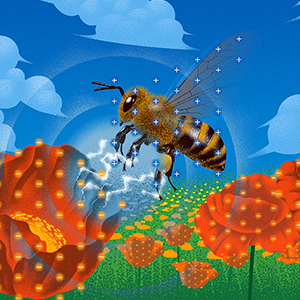We're sunsetting PodQuest on 2025-07-28. Thank you for your support!
Export Podcast Subscriptions
The Hidden World of Electrostatic Ecology
2025/2/19

Quanta Science Podcast
A
Anna Dornhaus
B
Benito Wainwright
B
Beth Harris
D
Daniel Robert
S
Sam England
V
Victor Ortega Jimenez
Daniel Robert: 我和我的团队发现蜜蜂能够探测和区分来自花的电场,这为我们理解昆虫与环境的相互作用开辟了新的视角。
我们进一步的研究揭示了静电在植物和传粉者之间的互利共生关系中扮演着关键角色,这是一种共同进化。
昆虫利用静电场是偶然的还是适应性的,这仍然是一个有待研究的问题。
Anna Dornhaus: 静电在生态系统中的作用长期以来被低估了,部分原因是它对人类来说是无形的。
我们通常更关注那些可见的性状,而忽略了那些隐藏的、但同样重要的生态过程。
对静电的深入研究,将有助于我们更全面地理解自然界的复杂性。
Benito Wainwright: 自然界中许多性状的出现并非总是通过适应性过程,但一旦出现,进化就会对其产生作用。
静电在昆虫生态学中的作用已经得到证实,但我们仍然需要进一步研究来了解其进化机制。
对静电的深入研究,将有助于我们更全面地理解自然界的复杂性。
Victor Ortega Jimenez: 我偶然发现静电在昆虫行为中的作用,这让我意识到静电在小型生物的生存中起着重要作用,因为它们的世界受静电力影响比重力更大。
小昆虫由于其形状和表面积与体积之比,更容易积累静电荷。
我们需要更多来自野生动物的数据来研究静电在捕食者-猎物相互作用中的作用。
Sam England: 我设计了实验来测量昆虫的静电荷,发现昆虫利用静电吸引花粉可以提高传粉效率。
夜行性飞蛾的静电荷通常比其他物种低,这可能是为了避免被依赖非视觉线索的捕食者发现。
毛毛虫可以通过感知静电来检测捕食者,这在捕食者-猎物相互作用中具有进化意义。
Beth Harris: 各种不同生态环境的物种都利用静电,这表明静电在生态系统中扮演着重要角色。
静电在动物界的影响可能比我们目前所知的更大。
对静电的深入研究,将有助于我们更全面地理解自然界的复杂性。
Deep Dive
Insects and other small creatures utilize static electricity for various purposes, including travel, predator avoidance, and pollen collection. New research explores how evolution might have shaped this phenomenon, opening up a new field of study called aerial electroreception.
- Insects use static electricity for travel, predator avoidance, and pollen collection.
- Aerial electroreception is a new field of study exploring the ecological effects of static electricity.
- Static electricity may be an evolutionary force in small creatures' survival.
Shownotes Transcript
Invisibly to us, insects and other tiny creatures use static electricity to travel, avoid predators, collect pollen and more. New experiments explore how evolution may have influenced this phenomenon.
The post The Hidden World of Electrostatic Ecology) first appeared on Quanta Magazine)